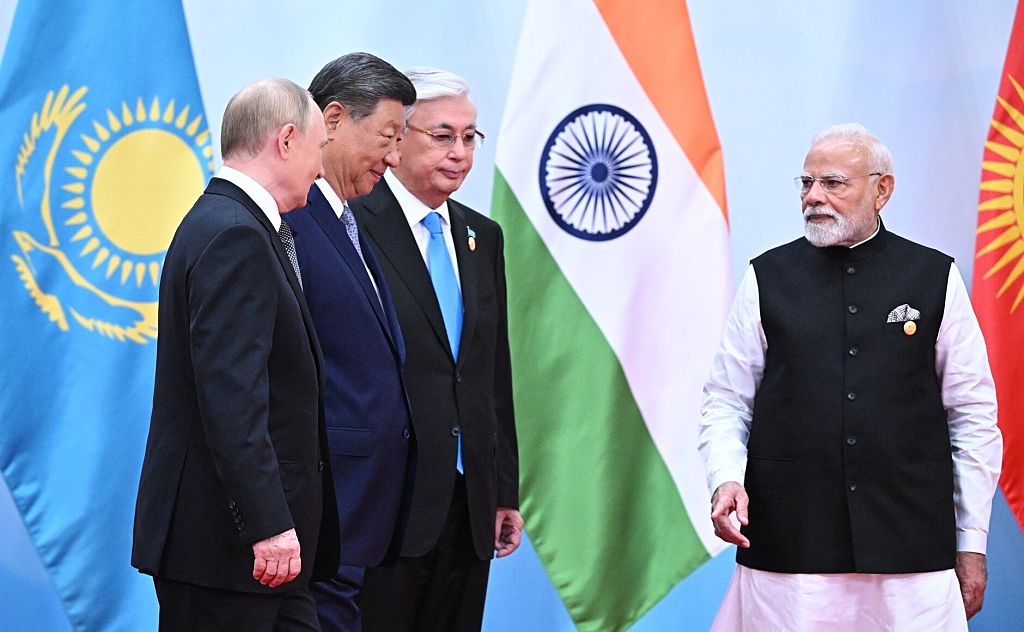The Shanghai Cooperation Organization summit in Tianjin, China grabbed the world’s attention this weekend. Much of the commentary was centered on the presence of India’s Prime Minister Narendra Modi, who visited China for the first time in seven years. Photographs from Tianjin showed Modi with China’s Xi Jinping and Russia’s Vladimir Putin.
[time-brightcove not-tgx=”true”]
This prompted two lines of narrative. The first was that Modi, stung by President Donald Trump’s imposition of steep tariffs on India exports to the U.S., was pivoting toward China: Trump had pushed an American friend into the arms of America’s enemy. The second was that Modi’s arrival in Tianjin signaled the emergence of a new global alliance—led by China, supported by Russia and India—against the U.S.
My view: Both of these conclusions are too hasty, and fail to reckon with the cold economic and geopolitical reality that India can’t afford to cut ties with the U.S.
Now, there’s no gainsaying that Trump’s behavior toward India has been despicable. There’s credible reporting to suggest that the U.S. president’s imposition of 50% tariffs on Indian exports was in large part the product of spite.
Having falsely claimed credit for brokering a ceasefire between India and Pakistan earlier this year, Trump wanted Modi to publicly express gratitude—and to nominate him for the Nobel Peace Prize. Pakistan’s prime minister had done so, but Modi refused to play ball, infuriating Trump.
The tariffs, accompanied by scornful rhetoric from Trump about India’s “dead economy,” made it hard for Modi to sustain a longstanding narrative that he had developed a special friendship with the American leader. For months, officials in New Delhi had been crowing that their prime minister was Trump’s main man in Asia, and that the U.S. regarded India as an essential bulwark against China.
Now, Trump has shown how little he cares for Modi—and for India.
It is reasonable to assume that Modi might not have gone to Tianjin if the tariff negotiations had gone differently. For one thing, he has long regarded Xi with suspicion bordering on hostility, and had refrained from visiting India’s giant neighbor to demonstrate unhappiness at China’s policies toward India. These include economic, military, and diplomatic support for Pakistan and aggressive claims on Indian territory, accompanied by land grabs and clashes along the border.
For another, Modi would not have relished having to rub shoulders with many of the other attendees, such as Pakistan’s Shehbaz Sharif and Turkey’s Recep Tayyip Erdogan; the latter was recently denounced by New Delhi for taking sides with Islamabad during the India-Pakistan mini war in February. Most of the countries represented at the summit were represented by autocrats of one or other description—such as Iran’s Masoud Pezeshkian and Belarus’s Aleksandr Lukashenko.
The presence of India’s prime minister provided some democratic gloss to this parade of pariahs. (Indonesia’s Prabowo Subianto was a late cancellation.) This served Xi’s ego—much more than a Nobel nomination would have sated Trump’s—as well as his geopolitical ambitions. It would have pleased Putin, too, since the Russian leader could claim to have brought the Asian giants closer.
In effect, Modi had gone from being America’s main man to playing third banana at China’s banquet. No amount of mugging before the cameras in Tianjin could mask the comedown this represents.
But that doesn’t mean India is pivoting away from the U.S. in an eastwardly direction. The bald reality is that it simply can’t afford to do so.
It’s the economy, stupid. India’s exports to the U.S., closing in on $90 billion annually, far exceed its exports to all the members of the Shanghai Cooperation Organization, taken together. Xi and Putin can smile in Modi’s general direction, but they can’t make up for the loss in export revenues that will result from Trump’s tariffs. China and Russia want to sell more to India, not buy more from it.
It’s also the geopolitics, stupid. For all the talk of the Chinese dragon and the Indian elephant joining in an embrace, the fact remains that Beijing views New Delhi as a rival—more like an uppity competitor—in need of occasional smackdowns. China will remain Pakistan’s primary patron, and will continue to claim large swaths of Indian territory. Nor is India likely to walk away from military alliances with the U.S. and other Asian nations, alliances that Beijing regards as unfriendly but New Delhi views as existential.
For these reasons alone, Modi knows he cannot stray too far from Washington’s orbit. He will need to find a face-saving way to make up with Trump: India’s economy and security depend on it.
Right now, Indian diplomats and lobbyists in Washington are working feverishly to engineer a rapprochement. They may have hoped that Trump would see those pictures of Modi grinning alongside Xi, and be alarmed at the prospect of losing an American friend. Fat chance: Trump’s reaction to Modi’s trip to Tianjin has been scornful, claiming that India is offering to drop all tariffs on American goods.
None of this will be lost on Xi. Ever the geopolitical realist, the Chinese president will know Modi’s presence at his banquet was opportunistic at best, and doesn’t indicate the start of a beautiful friendship.
He must know, too, that without India his grand alliance against the U.S. and the West is a non-starter. The likes of Indonesia and Turkey will always be careful to keep a foot in both camps. When Modi has made up with Trump, Xi will be left with Putin and the other pariahs.

